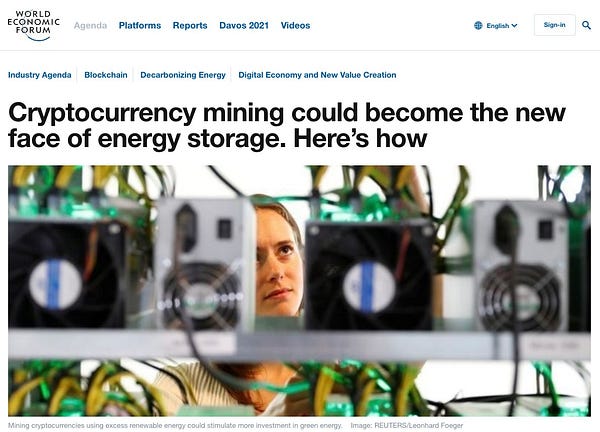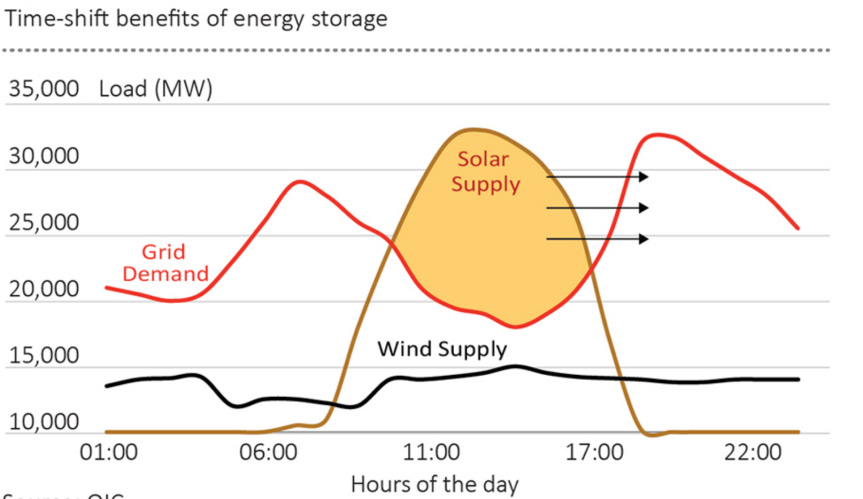Some people think Bitcoin can store energy. For example, Meltem Demirors recently tweeted:

My friend Balaji Srinivasan approved, writing:



Unfortunately it doesn’t quite work like that. Bitcoin — like any financial asset — cannot store energy. But it might be able to help speed the transition to green energy in other ways.
Bitcoin is physically incapable of storing energy
Suppose you have a solar plant in Morocco, and you want to transmit a joule of energy to Britain. You could use the solar plant to charge a battery and mail it to Britain (pretty inefficient). You could build a bunch of very long cables to transmit the energy to Britain (technologically challenging and economically risky). But you can’t simply mine BTC and then send the BTC to Britain. That doesn’t store any energy.
The reason is just physics — BTC is an entry in a ledger, and as such it does not contain any energy. The recipient in Britain physically cannot use the BTC that your Moroccan producer sent him to create another joule of energy — or even a femtojoule. BTC cannot be converted into any energy at all.
Now, the British recipient could pay a local producer to produce a second joule of energy. But this isn’t storage. The new joule is a new joule. All you did was to produce 2 joules (one in Morocco, one in Britain) rather than to store and transmit 1 joule. You might as well have ignored Morocco and just produced 1 joule in Britain in the first place.
In other words, no matter how much money Moroccans send to Britain, Britain will still need to produce exactly the same amount of energy locally in order to keep the lights on. No transfer of energy has occurred.
But Bitcoin might help finance solar
But just because Bitcoin can’t store energy doesn’t mean it has no role to play in the green energy revolution.
Solar electricity is inherently intermittent — it produces more energy when the sun is shining. That means it produces less electricity during the winter, on cloudy or rainy days, and during morning and evening (and none at night).
Physical storage is one way of dealing with intermittency. You produce as much energy as you can during the sunny hours, and then you store that energy in a battery or in water reservoir etc. Then you draw down the energy when you need it. In fact, if you want energy at night, when there’s no sun at all, you definitely need physical storage.
But another way of dealing with intermittency is to overbuild. You build so many solar panels that even on a cloudy winter morning you can produce enough to power your home or office or factory.
But overbuilding costs money. Yes, solar is coming down fast in price, but it would still be nice to have some way to defray the costs of overbuilding.
Well, Bitcoin may help with that. If you build enough solar to power you during a cloudy winter morning, you have a lot of extra, wasted capacity on a clear summer midday. This is what produces the famous “duck curve”.
So if you’re not going to store it, what do you do with all that extra solar electricity during the sunny times? One thing you could do is to use it to mine Bitcoin. That will make some money for the utility company, which it can then use to recoup some of the cost of building the solar plant in the first place.
In other words, using extra solar peak capacity for BTC-mining could make solar a better financial proposition for a utility in the first place. And that could speed the transition away from fossil fuels. When the World Economic Forum called Bitcoin “energy storage”, this is what it actually meant. They should probably use a better phrase that reflects the purely financial nature of Bitcoin’s addition to the solar ecosystem.
Also, note that Morocco is totally left out of this equation. Because Bitcoin can’t store or transmit energy, the solar power that mines the Bitcoin that British solar plants use to defray their cost has to be generated on-site. Sorry, Morocco.
The problem with Bitcoin-for-solar
The big problem with this BTC-for-solar-financing scheme is that it might not scale up; as more Bitcoin miners enter the ecosystem, the returns from mining fall. So individual utilities that build Bitcoin-mining rigs and attach them to their solar plants might experience much lower-than-expected financial returns if a whole lot of other utilities choose to do the same. If utilities take losses from building mining rigs that don’t pay for themselves, it could even potentially cause a bust in the solar industry.
A solution is to make Bitcoin-mining only one of many things that utilities do with the extra electricity during sunny hours. There are all kinds of other industrial processes that we could set up to run only for a few hours a day. For example, we could set up a bunch of electric-powered tedders and swathers so we could make hay while the sun shines. Or we could do something else that isn’t a tortured way to set up a bad pun. Like desalinating water or electrolyzing water for hydrogen or rendering animation or running semiconductor fabs or whatever. The best things are anything you can do intermittently, in short intense bursts, where missing a day due to clouds or rain doesn’t matter that much.
In other words, we should see Bitcoin mining as just one of many industrial processes that could be restructured to run off of excess peak solar electricity.
By the way, remember that if you like this blog, you can subscribe here! There’s a free email list and a paid subscription too!





I would rather see the excess energy used for direct air capture of carbon.
One of the more imaginative uses I've heard suggested for intermittent solar power is distilling rum. Oops, can't do that in Morocco.
An obvious one is smelting aluminium, which uses huge amounts of electricity. Existing smelters, I'm told, are mostly located near big hydroelectric dams, but there are sunny countries that already mine bauxite. Oh, and: https://en.m.wikipedia.org/wiki/Aluminium%E2%80%93air_battery